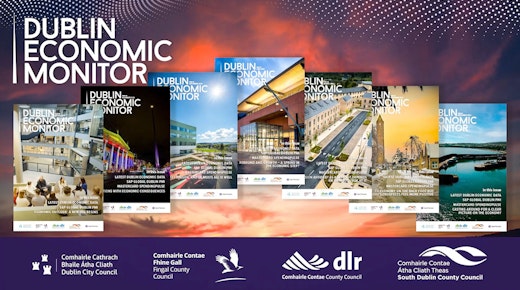Following a number of years of difficult economic conditions, the Irish and Dublin economies have recovered to rank amongst the most competitive in Europe.
Business costs in the capital remain relatively low, while the labour market has improved and contributed to high levels of value added per capita. The challenge for policymakers is to ensure that this competitiveness is maintained through the uncertain times which lie ahead.
An improving national picture
After dropping to 24th place in the IMD Competitiveness rankings in 2011, Ireland climbed again to 6th position this year, our highest placing since 2001. As the capital city, comprising 45% of the national economy, Dublin’s competitiveness warrants closer investigation within this overall picture. This article summarises some recent analysis by Fingal County Council which considers the region’s competitiveness in a comparative international context.

Employment and productivity
Dublin has experienced steady productivity growth over the past number of years. Of comparator cities included in this analysis, only two had higher gross value added per capita in 2016 and while a portion of this can be accounted for by issues affecting Ireland’s GDP measurement, the divergence between Ireland’s productivity growth and that of the EU has been evident from the late 1990s(1).

Employment in Dublin has increased by 13.4% between 2010 and 2017, equating to a net increase of 74,4002(2) jobs, the strongest rate of employment growth across EU cities benchmarked here. Dublin has also had the largest reduction in unemployment.

Business costs
While the range of business costs are typically higher in Dublin than elsewhere in Ireland, comparisons with international cityregions show more moderate results.
Dublin has remained reasonably priced for office space. Compared to London, the cost of construction of office space is 41% more competitive and the construction of high-tech manufacturing premises is 27% cheaper(3).
While data for Dublin is not available across all metrics, national indicators show a reasonable performance. To date, Irish wage growth has been largely contained despite tightening in the labour market. Average labour costs in Ireland compare favourably with major European economies and energy costs – such as natural gas and industrial electricity – are also competitively priced(4).
“Overall, producer price indices show that Ireland’s business costs are broadly growing in line with those typical of EU countries.”

Knowledge economy
Turning first to national data, of those who have completed education, 48% have a third-level qualification. Further, a comparatively large portion of these qualifications are in high value-adding fields, such as science, technology, engineering and maths (STEM).
This is reflected in the concentration of the Dublin workforce employed in high value-adding sectors of the economy, with 7.4% of people employed in ICT and 8.7% in the financial and insurance sector. Again, this is higher than most comparator city regions.

The data bears out the strength and importance of particular sectors of the region’s economy. IDA Ireland has highlighted our attractiveness for technology sector investment projects and Dublin has been to the fore in this regard. In addition to talent availability set out here,
Dublin brings clear advantages in terms of our track record, connected technology infrastructure and vibrant start-up scene. Similarly, the data underlines strengths in financial services activity in Dublin. In the aftermath of Brexit, further investment in this sector is anticipated and this can assist in ameliorating negative impacts elsewhere in the region’s economy.

Policy Challenges
While much of this analysis points to the ongoing strengths of Dublin as an investment location, close attention must be paid to challenges and pitfalls on the horizon. These include uncertainties in relation to Brexit, the need to address supply-side issues in the city’s economy – principally housing – continuing efforts to increase the level of innovation in the enterprise base in Dublin and guarding against the threat of wage inflation as the labour market tightens further.
Policymakers must remain vigilant to these and other issues to ensure that the relative gains achieved over the past number of years are not eroded.
Source:
1. Eurostat data shows that Irish productivity has increased by 131.3% between 1996 and 2016, compared to average EU growth of 29.5%.
2. CSO quarterly national household survey Q4 2010 – Q2 2017.
3. Turner and Townsend: International Construction Market Survey 2016
4. Eurostat data shows that labour cost per hour and income tax and social security contributions are lower in Ireland than in many other European economies, including Austria, Germany, Netherlands, France and Belgium. Industrial electricity is cheaper than the EU average in Ireland, with natural gas marginally more expensive than the EUaverage.





